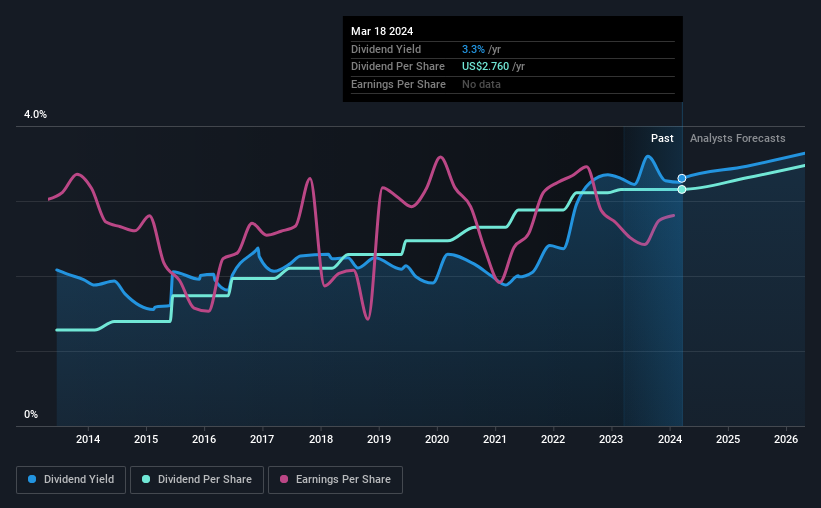Two Days Left Until Medtronic plc (NYSE:MDT) Trades Ex-Dividend
It looks like Medtronic plc (NYSE:MDT) is about to go ex-dividend in the next two days. The ex-dividend date occurs one day before the record date which is the day on which shareholders need to be on the company's books in order to receive a dividend. The ex-dividend date is of consequence because whenever a stock is bought or sold, the trade takes at least two business day to settle. In other words, investors can purchase Medtronic's shares before the 21st of March in order to be eligible for the dividend, which will be paid on the 12th of April.
The company's next dividend payment will be US$0.69 per share. Last year, in total, the company distributed US$2.76 to shareholders. Calculating the last year's worth of payments shows that Medtronic has a trailing yield of 3.3% on the current share price of US$83.57. We love seeing companies pay a dividend, but it's also important to be sure that laying the golden eggs isn't going to kill our golden goose! As a result, readers should always check whether Medtronic has been able to grow its dividends, or if the dividend might be cut.
View our latest analysis for Medtronic
Dividends are usually paid out of company profits, so if a company pays out more than it earned then its dividend is usually at greater risk of being cut. It paid out 87% of its earnings as dividends last year, which is not unreasonable, but limits reinvestment in the business and leaves the dividend vulnerable to a business downturn. We'd be concerned if earnings began to decline. Yet cash flows are even more important than profits for assessing a dividend, so we need to see if the company generated enough cash to pay its distribution. Over the last year it paid out 74% of its free cash flow as dividends, within the usual range for most companies.
It's positive to see that Medtronic's dividend is covered by both profits and cash flow, since this is generally a sign that the dividend is sustainable, and a lower payout ratio usually suggests a greater margin of safety before the dividend gets cut.
Click here to see the company's payout ratio, plus analyst estimates of its future dividends.
Have Earnings And Dividends Been Growing?
Stocks in companies that generate sustainable earnings growth often make the best dividend prospects, as it is easier to lift the dividend when earnings are rising. If earnings fall far enough, the company could be forced to cut its dividend. This is why it's a relief to see Medtronic earnings per share are up 6.7% per annum over the last five years. Decent historical earnings per share growth suggests Medtronic has been effectively growing value for shareholders. However, it's now paying out more than half its earnings as dividends. If management lifts the payout ratio further, we'd take this as a tacit signal that the company's growth prospects are slowing.
Many investors will assess a company's dividend performance by evaluating how much the dividend payments have changed over time. In the past 10 years, Medtronic has increased its dividend at approximately 9.4% a year on average. We're glad to see dividends rising alongside earnings over a number of years, which may be a sign the company intends to share the growth with shareholders.
To Sum It Up
From a dividend perspective, should investors buy or avoid Medtronic? Earnings per share have been growing modestly and Medtronic paid out a bit over half of its earnings and free cash flow last year. Overall, it's not a bad combination, but we feel that there are likely more attractive dividend prospects out there.
Curious what other investors think of Medtronic? See what analysts are forecasting, with this visualisation of its historical and future estimated earnings and cash flow.
Generally, we wouldn't recommend just buying the first dividend stock you see. Here's a curated list of interesting stocks that are strong dividend payers.
Have feedback on this article? Concerned about the content? Get in touch with us directly. Alternatively, email editorial-team (at) simplywallst.com.
This article by Simply Wall St is general in nature. We provide commentary based on historical data and analyst forecasts only using an unbiased methodology and our articles are not intended to be financial advice. It does not constitute a recommendation to buy or sell any stock, and does not take account of your objectives, or your financial situation. We aim to bring you long-term focused analysis driven by fundamental data. Note that our analysis may not factor in the latest price-sensitive company announcements or qualitative material. Simply Wall St has no position in any stocks mentioned.

